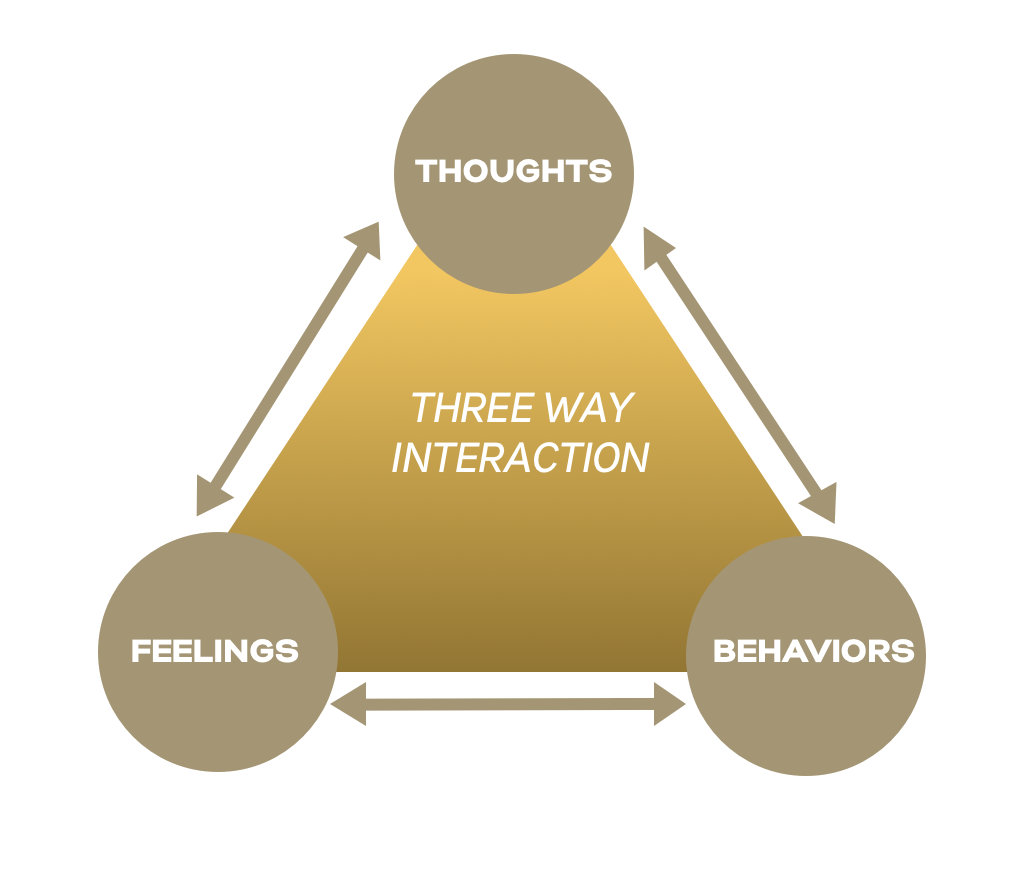While the CDC guidelines and other credible sources recommend staying at home, there are mental health consequences for some. These guidelines can lead to more time in bed, sitting on the couch, alone time, and little to no in-person social interactions. Some may be familiar with this state, and those are people who have experienced depressive episodes in the past. During a depressive episode, one feels a lack of energy and concentration, sleeping more than usual (or sometimes less), changes in mood, as well as low self-esteem and confidence. In response to these feelings, the urge is to do nothing, to stay at home, isolated and alone. This response only reinforces negative, unhelpful thoughts, making one feel sadder, and increasing the desire to stay home longer with no social contact. And the spiral continues.
According to cognitive-behavioral experts, our thoughts impact our feelings and behaviors. This relationship is a three-way interaction – meaning our behaviors impact our thoughts and feelings; our feelings impact our thoughts and behaviors, and our thoughts influence our feelings and behaviors. Below is a simple image depicting the relationship between behaviors, thoughts, and emotions.

Below are three strategies to consider.
- Social Interaction: With new platforms such as House Party, Zoom, FaceTime and WhatsApp, we can do video calls, eat together, listen to music, chit chat, and more. Families can connect across the world and feel like they are with each other. There are also social platforms that we can utilize to connect with others and see how they are spending their time. Depending on our preferences, we may even find groups of common interest and participate in group activities.
- Physical Activity: Most group exercises are now offered online, such as SoulCycle, Rumble, and Peloton. There are also free online classes for at-home exercises that need no instruments or tools; there are plenty on YouTube, Instagram and other platforms.
- General Activities: We can find various activities to do alone or with a quarantined partner. Some include dancing, singing, listening to music, watching favorite shows, playing video games (to a limit), making Legos or puzzles, taking baths, cooking or baking, and catching up on self-care (e.g., a facemask, a hair treatment, or doing that home organization task that you never had time for). With partners, friends or siblings, we can set a “pretend date,” play board or card games, or just have long-overdue discussions.
- Acknowledge and Monitor Unhelpful Thoughts: It is common and normal to have unhelpful thoughts during these tough times, such as: overgeneralizing about the world and uncertainty of life; trying to predict the future; and catastrophizing (i.e., assuming worst outcomes). Such thoughts without facts are not helpful. Behavior can also give rise to unhelpful thoughts. For example: sitting on the couch and watching Netflix for hours can trigger the thought “I am useless,” “look what my life is like now,” and “I am so lonely.” These unhelpful negative thoughts should be acknowledged as they are important. Avoiding, ignoring (hard to do), or escaping will make it hard to redirect. It would be as if someone tells you not to think about the pink elephant in the room; you will most certainly think about the pink elephant in the room. By acknowledging the thoughts, you validate you and notice these thoughts and not fear them. They are thoughts just like any other thoughts but unpleasant at times.
- Redirect: This may be a difficult one and needs a lot of practice. Redirecting can come in many forms and shapes. Reading one blog post, article or even book would not make you an expert. However, some tools may help you practice redirecting unhelpful thoughts, and over time master this skill. One way to practice redirecting is by asking: what is the evidence for this thought? And present your case as you would present it to a hypothetical court (evidence for and against) and then ask yourself: is the thought valid? Most of the time, the answer will be no; you will find little evidence in support of the thought, and much against it
- Validate: Acknowledge and welcome the feeling, and know it is valid. Emotions do not need to be backed by facts to be valid; we can feel sad about something that someone else won’t, but that does not take away from your sadness.
- Understand: Understand that there are no set feelings – there is no black or white with emotions, and we can experience different feelings at the same time, or oscillate between them. We can feel sad about a situation and also feel happy about life in general or vice versa.
- Ride: Ride the wave of emotions. Emotions do not last forever; in fact, they often last for a very short period of time. Fighting an emotion can make it last longer. It might seem counterintuitive but sticking with an emotion and allowing yourself to experience it, usually helps it go away faster. We can ride its wave, and once we do, it is so much easier to move past the hard feelings. Stay with it, acknowledge it, be kind to yourself, and then you can move on. This does not mean we should stay with negative feelings for a long time; the goal is to stay with the feelings, understand them, and acknowledge them, in order to enable us to feel comfortable to let them float by.


